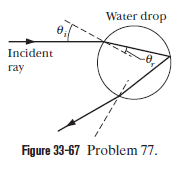Rainbow Figure 33-67 shows a light ray entering and then leaving a falling, spherical raindrop after one internal reflection (see Fig. 33-21a). The final direction of travel is deviated (turned) from the initial direction of travel by angular deviation
. (a) Show that localid="1664200532112" is localid="1664200226807" , where localid="1664200612169" is the angle of incidence of the ray on the drop and localid="1664200615282" is the angle of refraction of the ray within the drop. (b) Using Snell’s law, substitute for localid="1664200618431" in terms of localid="1664200621396" and the index of refraction n of the water. Then, on a graphing calculator or with a computer graphing package, graph localid="1664200624361" versus localid="1664200627334" for the range of possible localid="1664200636137" values and for localid="1664200630531" for red light (at one end of the visible spectrum) and localid="1664200633245" for blue light (at the other end). The red-light curve and the blue-light curve have a different minimum, which means that there is a different angle of minimum deviation for each color. The light of any given color that leaves the drop at that color’s angle of minimum deviation is especially bright because rays bunch up at that angle. Thus, the bright red light leaves the drop at one angle and the bright blue light leaves it at another angle minimum deviation from the localid="1664200639414" curve for (c) red light and (d) blue light. (e) If these colors form the inner and outer edges of a rainbow (Fig. 33-21a), what is the angular width of the rainbow?





